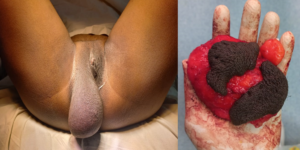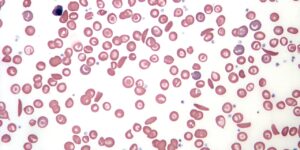Volume 4, Issue 1 | JSMS
Eskandar K. Artificial intelligence in healthcare: explore the applications of AI in various medical domains, such as medical imaging, diagnosis, drug discovery, and patient care. Series Med Sci. 2023;4(1):37-53.
With over 90% accuracy in diagnosing diseases from medical images, artificial intelligence (AI) is reshaping the healthcare landscape, transforming medical imaging, diagnosis, drug discovery, patient care, and more. This captivating literature review explores AI's multifaceted applications, illuminating its potential to streamline healthcare management and surgical procedures. While unlocking exciting possibilities, challenges such as ethics and biases demand scrutiny. Engaging statistics and compelling case studies showcase AI's current impact and inspire further collaboration in this awe-inspiring technological revolution, propelling us toward a future where AI collaborates seamlessly with healthcare professionals for superior patient outcomes.
Article DOI: 10.54178/2771-0629.2023a7
Abstract
Full TextPDF Cite
Walawe Nayaka S, Wickramasinghe NH, Senevirathne JTN. Large vulvar lipoma presented as a pedunculated labial mass. Series Med Sci. 2023;4(1):33-36.
Lipomas are the most common subcutaneous mesenchymal neoplasm commonly seen over trunks and limbs. Even though vulvar lipomas are rare, their clinical nature is similar to lipomas in other sites of the body. Diagnosis is usually made on clinical findings, and surgical excision is the best treatment option. This is a case of large pedunculated vulvar lipoma in a 30-year-old lady.
Article DOI: 10.54178/2771-0629.2023a6
Abstract
Full TextPDF Cite
Nehme P, Al Awar O, Dabbous A. Lumbar transforaminal epidural platelet-rich plasma injections: the novel modality for the treatment of low back pain. Series Med Sci. 2023;4(1):29-32.
Background: The low back pain is a common health problem. It causes significant morbidity that limits economic productivity. Platelet-rich plasma (PRP) has been shown to be effective in cosmetic surgical procedures and help accelerate wound healing in trauma and joint injuries. PRP injections use each patient’s healing system to improve musculoskeletal problems. Therefore, we investigated the use of lumbar transforaminal epidural PRP (TEPRP) injections for the treatment of low back pain patients.
Methods: We evaluated a pain numerical rating scale (NRS) for a total of 210 patients with low back pain at the level of L3-4-5 immediately before the procedure. The patients completed the pain NRS. The score was 0 for no pain and 10 for the worst pain. A successful categorical outcome was defined as a reduction in pain by at least 50%. We also evaluated an assessment of the immediate post-procedure NRS, at 2 weeks, and measured the successful outcomes at 2 months.
Results: Immediate NRS response was weakly associated with 2-month outcomes. Patients who responded at 2 weeks were more likely to be responders at 2 months than those who were non-responders at 2 weeks.
Conclusion: Immediate post-TEPRP pain relief does not strongly predict long-term effectiveness in pain relief or functional recovery. Response in pain relief or functional recovery at 2 weeks is more strongly associated with 2-month outcomes.
Article DOI: 10.54178/2771-0629.2023a5
Farajirad M, Farajirad E, Motlagh Pirooz F, et al. Remarkable spontaneous regression of third ventricle colloid cyst: a compelling case report and neurosurgical literature review. Series Med Sci. 2023;4(1):24-28.
Background: Colloid cysts (CC) are infrequent and benign cystic formations located in the third ventricle proximate to the foramen of Monro. Although surgical resection is widely acknowledged as the standard approach for managing symptomatic large-sized CC, the necessity of surgical intervention for asymptomatic or minimally symptomatic cases remains a subject of ongoing debate.
Case Presentation: In this report, we present the case of a 34-year-old female patient who complained of severe headaches. She was totally alert with normal cranial nerves examination and acute papilledema. Magnetic resonance imaging (MRI) revealed a characteristic 12 mm-sized CC situated in the third ventricle. Furthermore, fluid-attenuated inversion recovery (FLAIR) MRI demonstrated severe hydrocephalus with periventricular edema. Surprisingly, the patient was thoroughly informed of the potential treatment options during the first visit, including the possibility of neurosurgical tumor resection. However, the patient expressed reluctance and declined to provide consent for the neurosurgical intervention at that time. Remarkably, subsequent MRIs conducted 18 months after the initial evaluation demonstrated a spontaneous reduction in cyst size from 12 mm to 2 mm.
Conclusion: The phenomenon of spontaneous regression in CC is an exceedingly rare event. For carefully selected, asymptomatic cases, an alternative management approach involving regular imaging surveillance and frequent neurological assessments could be considered. However, the decision-making process should be meticulous, with a comprehensive evaluation of the associated risks and potential benefits of surgical intervention vs. conservative observation tailored to each case. Further research and larger studies are warranted to validate the feasibility and long-term outcomes of this alternative management strategy.
Article DOI: 10.54178/2771-0629.2023a4
Abdullayevich BE, Zokirovich AB, Teshaevich SS. Comparative approaches to prevention, rehabilitation and tactics of treatment of adhesive intestinal obstruction in children. Series Med Sci. 2023;4(1):18-23.
This article analyzes the experience of treatment of 111 children with various forms of adhesive impassability of intestines. The differentiated approach is put on a treatment basis in a choice of operative or conservative methods of treatment depending on the form of the disease, clinical features of a current, and efficiency of spent conservative actions. The specified principle in tactics choice has allowed to lower a considerable quantity of possible vain operations and their complications; to avoid lethality, it is essential to lower risk reoperations. The complex program of rehabilitation used in clinical practice and preventive maintenance of adhesive impassability has allowed to reduce the quantity of relapses of disease.
Article DOI: 10.54178/2771-0629.2023a3
Abstract
Full TextPDF Cite
Lyande LB, Limbaya Ekanga NMJ, Amisi BM, et al. Severe anemia during pregnancy: prevalence, risk factors and maternal-fetal prognosis. Series Med Sci. 2023;4(1):9-17.
Anemia is one of the most important public health problems in the world and concerns the World Health Organization (WHO) given its prevalence, its many etiologies but also the consequences for which it is responsible in mothers and young children. In pregnant women, the causes of anemia are multiple and often intertwined: iron deficiency (but also folic acid, vitamin, etc.), intestinal helminthiasis, malaria, other infections (HIV infection, etc.), and hemoglobinopathies are the main causes. But among these etiologies, it has been estimated that 75% of anemias are attributable to iron deficiency and remain a cause of considerable perinatal morbidity and mortality. To avoid this, health services should design and implement strategies to control anemia in pregnant women, including prevention, early diagnosis, and appropriate management. The objective is to contribute to improving the management of anemia during pregnancy in order to reduce maternal and fetal morbidity and mortality linked to anemia in pregnant women.
Article DOI: 10.54178/2771-0629.2023a2
Knowledge of the Distribution and Frequency of ABO and Rhesus Blood Groups in the Community of Yangambi Case of Blood Donors Monitored at the Yangambi Blood Transfusion Center (General Reference Hospital for INERA Yangambi)
Lyande LB*, Amisi BM, Kumiele PM, Limbaya Ekanga NMJ, Lomboto J, Lokenye Kabinda A and Lokondaita Baruti P
Lyande LB, Amisi BM, Kumiele PM, et al. Knowledge of the distribution and frequency of ABO and Rhesus blood groups in the community of Yangambi case of blood donors monitored at the Yangambi blood transfusion center (general reference hospital for INERA Yangambi). Series Med Sci. 2023;4(1):1-8.
Blood group antigens are hereditarily determined and play a vital role in blood safety. Blood types are known to have some association with many diseases. About 700 erythrocyte antigens have been described, organized into 30 blood group systems by the International Society of Blood Transfusion, of which the ABO and Rhesus systems are the most important. Thus, knowledge of the distribution of ABO and Rhesus blood groups at the local and/or regional level is of major importance in the management of blood banks and transfusion safety services.
Article DOI: 10.54178/2771-0629.2023a1







